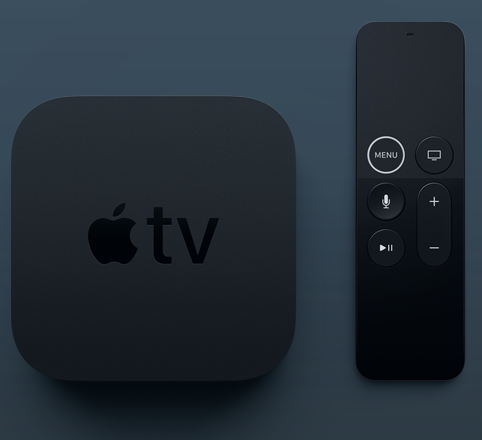Welcome to my sixth annual roundup of the top 10 consumer tech products of the past year. My criteria are entirely subjective. My goal is to identify tech products that provide consumers a great user experience with bonus points for being a great value.
 Apple TV 4K
Apple TV 4K
I have just about every set top device out there, but my Apple TV is the one I use regularly. I don’t do this because it has the most apps (tip of the hat to Roku). I don’t do it because I can see YouTube in its 4K glory. I do it because it is smooth and easy. The Apple TV 4K promises more of the same just at a higher resolution. Sadly, I still can’t use it to watch YouTube in 4K. That’s too bad because it is my second favorite source of 4K video after Netflix. Way pricier than the competition, starting at $179, but I still want one.
 DJI Spark
DJI Spark
You already have a great camera in your phone. Maybe you even have a “real” camera. You have an action camera you can strap to your mountain bike, snorkel mask, or other thrill-seeking apparatus. But what about making an establishing aerial view? The drone that breaks the barrier from requiring you to be a drone hobbyist to easy for the serious selfie-ist is the DJI Spark. So simple to operate that you can both fly it and take still or video selfies with nothing but hand gestures. It is way cool. I want a blue one. Starting at $499.
Sony’s 2017 Full Frame Cameras
With its A7 series of cameras, Sony put the camera world on notice that there was a new player in town. Although the controls weren’t as ergonomic as those of a Nikon or Canon, the battery-life was relatively pitiful, and there was no second memory card slot, the power of the OS and the quality of the images began to outstrip the competition.
 Now, in 2017, Sony has delivered the A9 for professionals that has solved almost every issue (although still leaving room to improve in the menu system). With a big buffer and a monster 20 fps, I totally expect to see a lot more Sonys on the sidelines of NFL games. Arguably the best camera money can buy. At $4,500, I would still consider it to be a bargain.
Now, in 2017, Sony has delivered the A9 for professionals that has solved almost every issue (although still leaving room to improve in the menu system). With a big buffer and a monster 20 fps, I totally expect to see a lot more Sonys on the sidelines of NFL games. Arguably the best camera money can buy. At $4,500, I would still consider it to be a bargain.
 But Sony also introduced the best value in a full frame camera, the Sony A7R III. A sort of baby brother to the A9, A7R III rings in at “only” $3,200. It ups the resolution to 42.4 MP, to boot. Even with the mechanical shutter, it will shoot at 8 fps. Sony has also finally included shooting in 4K on a high resolution camera making this camera a jack of all trades. The only downside is that you loose the Sony apps. That means there is no intervelometer for time lapse photography unless one purchases an external one. Sony, why this step backward? Hopefully, this will be resolved in a future firmware update.
But Sony also introduced the best value in a full frame camera, the Sony A7R III. A sort of baby brother to the A9, A7R III rings in at “only” $3,200. It ups the resolution to 42.4 MP, to boot. Even with the mechanical shutter, it will shoot at 8 fps. Sony has also finally included shooting in 4K on a high resolution camera making this camera a jack of all trades. The only downside is that you loose the Sony apps. That means there is no intervelometer for time lapse photography unless one purchases an external one. Sony, why this step backward? Hopefully, this will be resolved in a future firmware update.

 Sonos One
Sonos One
Why pay $200 for a Sonos One when you get all the brains of Alexa in an Amazon Dot for $50? Because you love a great sounding speaker. Like chocolate and peanut butter, Sonos has married great speakers with a great personal assistant. (Ever notice how much “trite and true” sounds like “tried and true”?) Sonos leads the pack in wireless speaker sound. Preliminary testing indicates that the sound profile is similar to the popular Play:1. They’re fidgety to obnoxious to set up, but once you tune them the sound will blow you away. When I finished tuning my sister’s Play:1, the quality of the sound literally gave me goose pimples.
 Apple Watch Series 3 with LTE
Apple Watch Series 3 with LTE
From the introduction of the Apple Watch, it has taken the wearable market by storm. But the Series 3, has moved the Apple Watch from a fun toy for tech-forward rich people to something so convenient and useful that anyone with the wherewithal and an iPhone should strongly consider it. Why? What if, leaving your phone at home, you could paddle board and still take phone calls? Jog and still listen to your tunes with your Air Pods? The addition of LTE gives us the opportunity to go unfettered from our phones for brief periods during the day.
Onboard storage stayed the same for the GPS-only version, but the LTE version doubles storage to 16GB.
One reason I went from iPhone to Nexus then Pixel was that there was no easy way to have my steps on the screen with an iPhone. The Apple Watch solves that problem with the Pedometer++ app providing a step “complication” (watch face feature). As my old surf watch begins to die, I’m also keeping a sharp eye on emerging surf apps for the Apple Watch (which is rated to 50 meters underwater).
The biggest limitation, is that it only works with an iPhone. Otherwise, Apple Watch would own the world.
 Fossil Q Activist Hybrid Smart Watch
Fossil Q Activist Hybrid Smart Watch
The Fossil Q Activist is no substitute for the features of an app wielding smartwatch (like an Apple Watch). The “hybrid” in the title means that it links with your phone to count steps, monitor your sleep, and nudges you with your phone notifications. You can shower or swim with it, but it won’t count laps or log how far you swim. So there are some things you sacrifice, but at only $155 it is a great value that looks stunning on one’s wrist. Also, you don’t need to charge it every night. Just change the battery every six months or so.
 LG OLED55B7A OLED 4K HDR Smart TV
LG OLED55B7A OLED 4K HDR Smart TV
If you’re looking for the best TV display money can buy, LG uses the same glass on their B-series TV’s as they do on their top of the line. If you’re serious about image quality, this $1600 beauty is the gateway to the OLED drug. Watch for the $1500 Black Friday pricing. It has been amazing to watch the OLED pricing come down so dramatically. This TV costs about what I paid for my old plasma HD TV nine years ago. And back in 2014, when I first put an OLED TV on this list it cost $3500 to get one in HD!
 TCL 55″ 55P607 4K UHD DOLBY VISION HDR ROKU SMART TV
TCL 55″ 55P607 4K UHD DOLBY VISION HDR ROKU SMART TV
There are those who argue that HDR is more important than 4K when viewing a TV from a normal distance. This little $650 gem provides HDR in both Dolby Vision and HDR10. While some expensive sets are literally omitting the TV tuner, essentially enslaving you to the cable company or an over the top (OTT) service, TCL hasn’t cheaped out there either. You can still hook up an antenna and watch TV for free. With 3 HDMI inputs, this is a value packed entertainment package. Roku doesn’t have the slick interface that Apple TV provides, but it does support all of the major apps including 4K YouTube, which the Apple TV lacks. (The Apple TV displays 4K YouTube videos in HD.) It may not have the highest rated display on the market, but from what I’ve seen it is pretty darn good and will put to shame the HD TV it is replacing in your home.
 iPhone X
iPhone X
iPhone X has arrived in time for Christmas and it is the real deal. It has been a while since I could argue that Apple made the best cell phone money could buy. In fact, last year Apple failed to make my top 10 list at all. But the iPhone X is the best phone money can buy. It is Apple, so we are talking a butt load of money here with prices starting at $999. So, yeah, you will have to fork over the price of a pretty fine computer to get one but I believe that it is worth every penny. The camera didn’t score quite as high as the Pixel 2 in the DxOMark ratings, but most people won’t see the difference and the scores of the two phones were very close.
What about the awful notch, you ask? I choose not to think of it as a notch, but as a viewing area with ears where extra info can be displayed. I’ve played with it and it just doesn’t bother me. Using gestures instead of a home button also came to me very quickly and I don’t miss my old homey a bit. But what about the continued lack of an earphone jack? Okay, you got me on that one.
Samsung can match or even surpass the iPhone on features, but good luck getting one of those to last you a year before the battery won’t hold a charge and the performance slows to a crawl. The Pixel 2 XL is pretty but the screen is a disaster. The Pixel 2 looks like something from three years ago (or an iPhone 8). If you’re looking for the best phone money can buy and a purchase that won’t fill you with regret before it’s time for your next upgrade, this is the one to buy.
Well, that’s it. While many electronic products are maturing and not quite as revolutionary as they once were, 2017 still introduced us to some great new products. Go forth and shop!
Note: I make no money when you buy items from this page and was paid no money to endorse these products.










